2005 BMW 325XI SEDAN roof
[x] Cancel search: roofPage 43 of 178
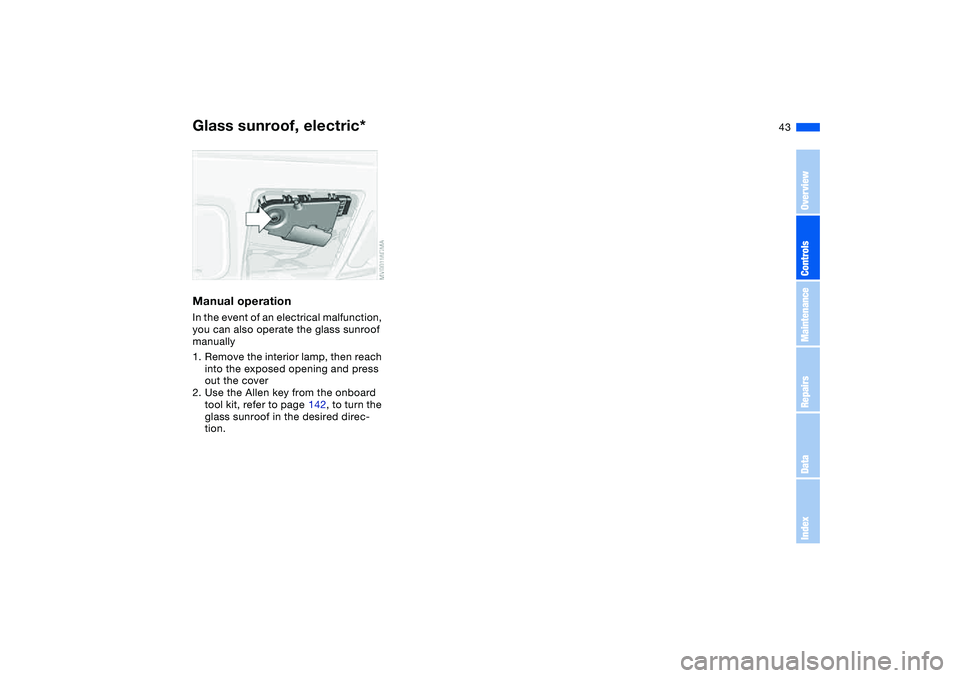
43
Manual operationIn the event of an electrical malfunction,
you can also operate the glass sunroof
manually
1. Remove the interior lamp, then reach
into the exposed opening and press
out the cover
2. Use the Allen key from the onboard
tool kit, refer to page 142, to turn the
glass sunroof in the desired direc-
tion.Glass sunroof, electric*
OverviewControlsMaintenanceRepairsDataIndex
Page 54 of 178
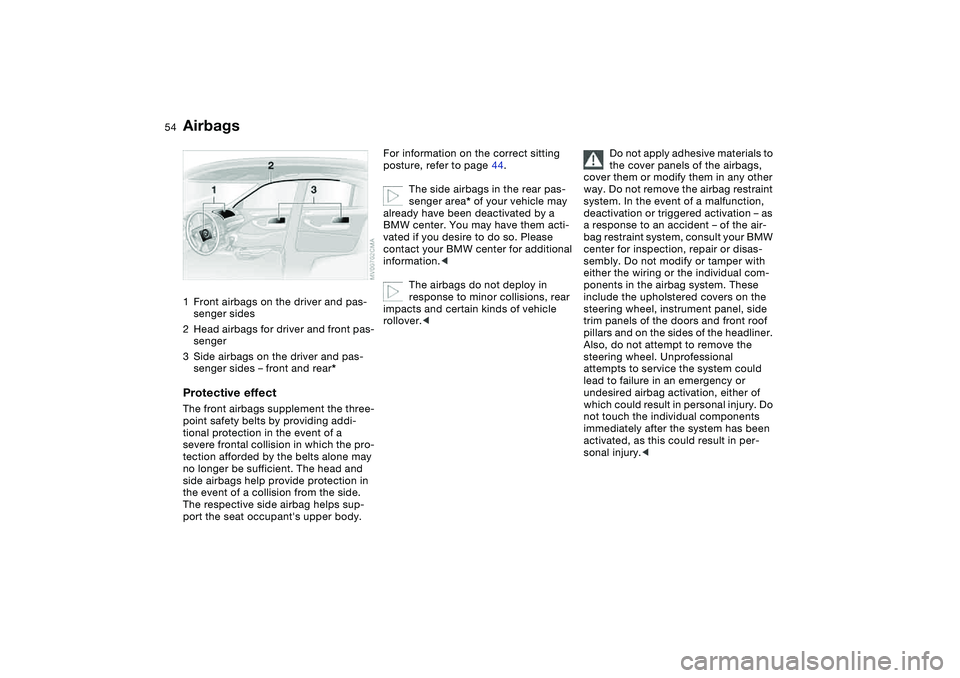
54Passenger safety systems
Airbags1Front airbags on the driver and pas-
senger sides
2Head airbags for driver and front pas-
senger
3Side airbags on the driver and pas-
senger sides – front and rear*Protective effectThe front airbags supplement the three-
point safety belts by providing addi-
tional protection in the event of a
severe frontal collision in which the pro-
tection afforded by the belts alone may
no longer be sufficient. The head and
side airbags help provide protection in
the event of a collision from the side.
The respective side airbag helps sup-
port the seat occupant's upper body.
For information on the correct sitting
posture, refer to page 44.
The side airbags in the rear pas-
senger area* of your vehicle may
already have been deactivated by a
BMW center. You may have them acti-
vated if you desire to do so. Please
contact your BMW center for additional
information.<
The airbags do not deploy in
response to minor collisions, rear
impacts and certain kinds of vehicle
rollover.<
Do not apply adhesive materials to
the cover panels of the airbags,
cover them or modify them in any other
way. Do not remove the airbag restraint
system. In the event of a malfunction,
deactivation or triggered activation – as
a response to an accident – of the air-
bag restraint system, consult your BMW
center for inspection, repair or disas-
sembly. Do not modify or tamper with
either the wiring or the individual com-
ponents in the airbag system. These
include the upholstered covers on the
steering wheel, instrument panel, side
trim panels of the doors and front roof
pillars and on the sides of the headliner.
Also, do not attempt to remove the
steering wheel. Unprofessional
attempts to service the system could
lead to failure in an emergency or
undesired airbag activation, either of
which could result in personal injury. Do
not touch the individual components
immediately after the system has been
activated, as this could result in per-
sonal injury.<
Page 112 of 178
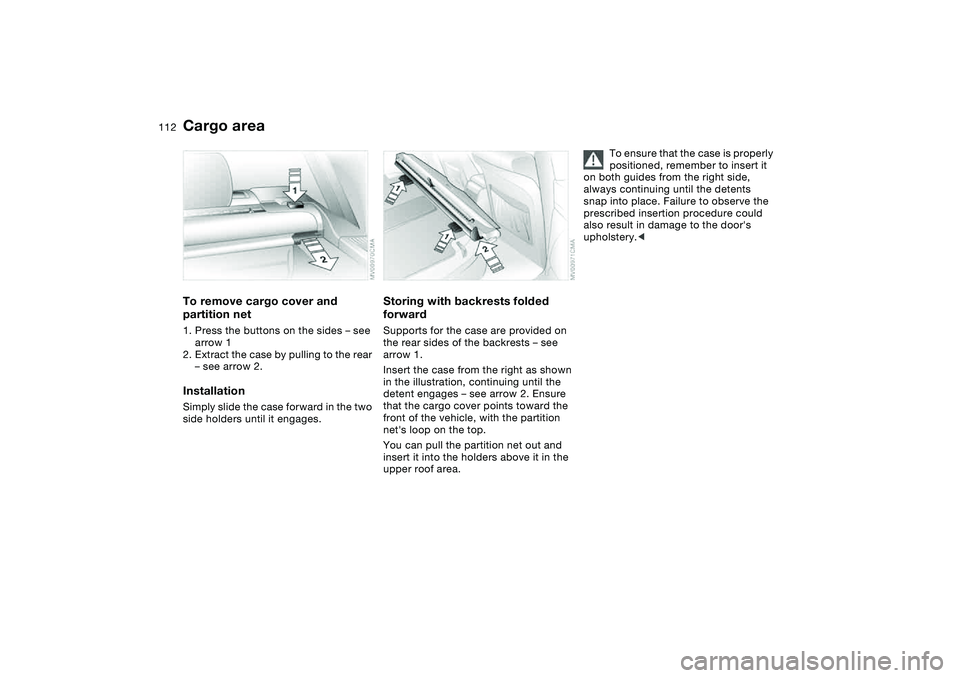
112
To remove cargo cover and
partition net1. Press the buttons on the sides – see
arrow 1
2. Extract the case by pulling to the rear
– see arrow 2.InstallationSimply slide the case forward in the two
side holders until it engages.
Storing with backrests folded
forwardSupports for the case are provided on
the rear sides of the backrests – see
arrow 1.
Insert the case from the right as shown
in the illustration, continuing until the
detent engages – see arrow 2. Ensure
that the cargo cover points toward the
front of the vehicle, with the partition
net's loop on the top.
You can pull the partition net out and
insert it into the holders above it in the
upper roof area.
To ensure that the case is properly
positioned, remember to insert it
on both guides from the right side,
always continuing until the detents
snap into place. Failure to observe the
prescribed insertion procedure could
also result in damage to the door's
upholstery.<
Cargo area
Page 116 of 178
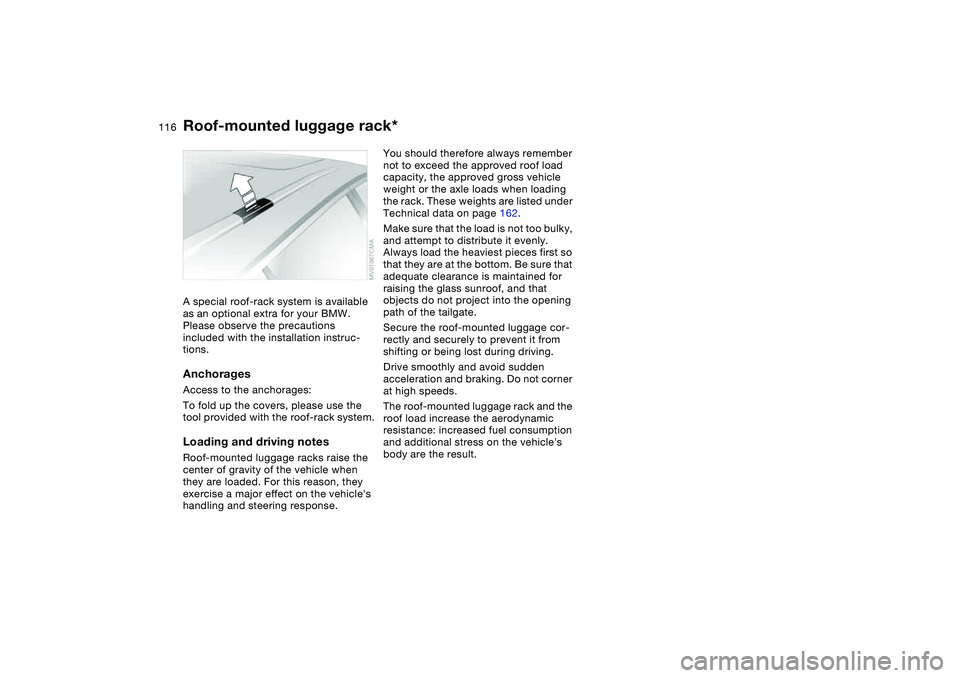
116
Roof-mounted luggage rack*A special roof-rack system is available
as an optional extra for your BMW.
Please observe the precautions
included with the installation instruc-
tions.AnchoragesAccess to the anchorages:
To fold up the covers, please use the
tool provided with the roof-rack system.Loading and driving notesRoof-mounted luggage racks raise the
center of gravity of the vehicle when
they are loaded. For this reason, they
exercise a major effect on the vehicle's
handling and steering response.
You should therefore always remember
not to exceed the approved roof load
capacity, the approved gross vehicle
weight or the axle loads when loading
the rack. These weights are listed under
Technical data on page 162.
Make sure that the load is not too bulky,
and attempt to distribute it evenly.
Always load the heaviest pieces first so
that they are at the bottom. Be sure that
adequate clearance is maintained for
raising the glass sunroof, and that
objects do not project into the opening
path of the tailgate.
Secure the roof-mounted luggage cor-
rectly and securely to prevent it from
shifting or being lost during driving.
Drive smoothly and avoid sudden
acceleration and braking. Do not corner
at high speeds.
The roof-mounted luggage rack and the
roof load increase the aerodynamic
resistance: increased fuel consumption
and additional stress on the vehicle's
body are the result.
Page 162 of 178

162
Weights
325i 325xi
Curb weight
with manual transmission/SMG
with automatic transmissionlbs/kg
lbs/kg3,362/1,525
3,450/1,5653,594/1,630
3,627/1,645
Approved gross vehicle weight
with manual transmission/SMG
with automatic transmissionlbs/kg
lbs/kg4,509/2,045
4,597/2,0854,696/2,130
4,729/2,145
Approved front axle load lbs/kg 1,984/900 2,139/970
Approved rear axle load lbs/kg 2,668/1,210 2,657/1,205
Approved roof load capacity lbs/kg 165/75 165/75
Cargo area capacity cu ft/l 15.4-57.1/435-1,617 15.4-57.1/435-1,617
Approved axle loads and approved gross vehicle weight must never be exceeded.
Page 168 of 178

Everything from A to ZCleaning light alloy wheels,
refer to the Caring for your
vehicle brochure
Cleaning the vehicle, refer to
the Caring for your vehicle
brochure
Cleaning windshield 76
Clock 82
12-/24-hour mode 82
setting, refer also to the
Owner's Manual for
Radio/Onboard Computer
Closing
from inside 35
from outside 31
Clothes hooks 121
Clutch
breaking in 120
Cockpit 14
Code, refer to the Owner's
Manual for Radio/Onboard
Computer
Coin box 106
Cold start, refer to Starting
the engine 63
Compact disc operation,
refer to the Owner's Man-
ual for Radio/Onboard
Computer
Compartments 106
Compartments in cargo
area 113Compression ratio, refer to
Engine data 160
Computer 83
Condensation, refer to Air
conditioning mode 98, 102
Configuring settings, refer to
Vehicle Memory, Key
Memory 61
Connecting a vacuum
cleaner, refer to Cigarette
lighter 108
Consumption
display 79
Consumption, refer to Aver-
age fuel consumption 84
Control elements, refer to
Cockpit 14
Convenience operation
from outside 34
glass sunroof 32
windows 32
Coolant 134
indicator lamp 19, 80
level 134
temperature gauge 80
Coolant water, refer to Cool-
ant 134
Cooling, refer to Tempera-
ture 98, 102
Copyright 4Cornering Brake Control
(CBC) 121
warning lamp 18
Correct tires 127
Cover, refer to Cargo area
cover 111
Cruise control 77
indicator lamp 20
Cup holders, see Beverage
holders 106, 107
Curb weight, refer to
Weights 162
Current consumption, refer
to Energy control 79
Cylinders, refer to Engine
data 160
D
Dashboard, refer to
Cockpit 14
Data
capacities 163
dimensions 161
engine 160
technical 160
weights 162
Daytime driving lamps 93
DBC Dynamic Brake Control
19, 121
Deep water, refer to Water
on roadways 121Defrost position, refer
to Defrosting windows
99, 102
Defrosting and demisting
windows
air conditioning 99
automatic climate
control 102
Defrosting windows 99, 102
Defrosting windshield,
refer to Defrosting win-
dows 99, 102
Demisting windows
air conditioning 99
automatic climate
control 102
Determining the maximum
load 114
Differential
breaking in 120
Digital clock 82
Dimensions 161
Dipstick, engine oil 132
Disc brakes 122
Displacement, refer to
Engine data 160
Display lighting, refer to
Instrument lighting 94
Displays, refer to Instrument
cluster 16
Page 169 of 178
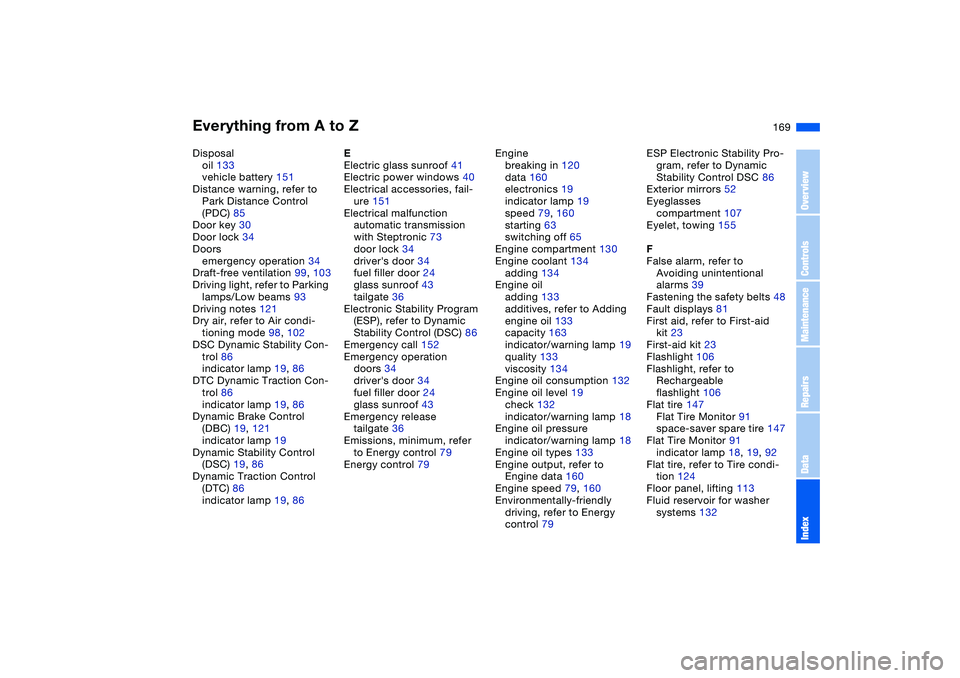
Everything from A to Z
169
Disposal
oil 133
vehicle battery 151
Distance warning, refer to
Park Distance Control
(PDC) 85
Door key 30
Door lock 34
Doors
emergency operation 34
Draft-free ventilation 99, 103
Driving light, refer to Parking
lamps/Low beams 93
Driving notes 121
Dry air, refer to Air condi-
tioning mode 98, 102
DSC Dynamic Stability Con-
trol 86
indicator lamp 19, 86
DTC Dynamic Traction Con-
trol 86
indicator lamp 19, 86
Dynamic Brake Control
(DBC) 19, 121
indicator lamp 19
Dynamic Stability Control
(DSC) 19, 86
Dynamic Traction Control
(DTC) 86
indicator lamp 19, 86E
Electric glass sunroof 41
Electric power windows 40
Electrical accessories, fail-
ure 151
Electrical malfunction
automatic transmission
with Steptronic 73
door lock 34
driver's door 34
fuel filler door 24
glass sunroof 43
tailgate 36
Electronic Stability Program
(ESP), refer to Dynamic
Stability Control (DSC) 86
Emergency call 152
Emergency operation
doors 34
driver's door 34
fuel filler door 24
glass sunroof 43
Emergency release
tailgate 36
Emissions, minimum, refer
to Energy control 79
Energy control 79Engine
breaking in 120
data 160
electronics 19
indicator lamp 19
speed 79, 160
starting 63
switching off 65
Engine compartment 130
Engine coolant 134
adding 134
Engine oil
adding 133
additives, refer to Adding
engine oil 133
capacity 163
indicator/warning lamp 19
quality 133
viscosity 134
Engine oil consumption 132
Engine oil level 19
check 132
indicator/warning lamp 18
Engine oil pressure
indicator/warning lamp 18
Engine oil types 133
Engine output, refer to
Engine data 160
Engine speed 79, 160
Environmentally-friendly
driving, refer to Energy
control 79ESP Electronic Stability Pro-
gram, refer to Dynamic
Stability Control DSC 86
Exterior mirrors 52
Eyeglasses
compartment 107
Eyelet, towing 155
F
False alarm, refer to
Avoiding unintentional
alarms 39
Fastening the safety belts 48
Fault displays 81
First aid, refer to First-aid
kit 23
First-aid kit 23
Flashlight 106
Flashlight, refer to
Rechargeable
flashlight 106
Flat tire 147
Flat Tire Monitor 91
space-saver spare tire 147
Flat Tire Monitor 91
indicator lamp 18, 19, 92
Flat tire, refer to Tire condi-
tion 124
Floor panel, lifting 113
Fluid reservoir for washer
systems 132
OverviewControlsMaintenanceRepairsDataIndex
Page 170 of 178
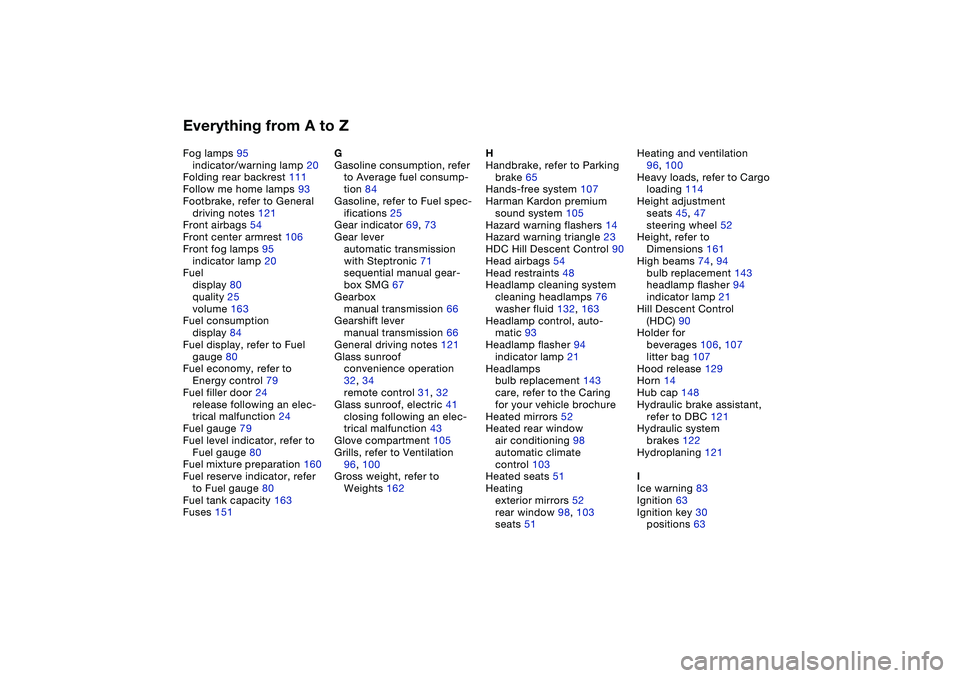
Everything from A to ZFog lamps 95
indicator/warning lamp 20
Folding rear backrest 111
Follow me home lamps 93
Footbrake, refer to General
driving notes 121
Front airbags 54
Front center armrest 106
Front fog lamps 95
indicator lamp 20
Fuel
display 80
quality 25
volume 163
Fuel consumption
display 84
Fuel display, refer to Fuel
gauge 80
Fuel economy, refer to
Energy control 79
Fuel filler door 24
release following an elec-
trical malfunction 24
Fuel gauge 79
Fuel level indicator, refer to
Fuel gauge 80
Fuel mixture preparation 160
Fuel reserve indicator, refer
to Fuel gauge 80
Fuel tank capacity 163
Fuses 151G
Gasoline consumption, refer
to Average fuel consump-
tion 84
Gasoline, refer to Fuel spec-
ifications 25
Gear indicator 69, 73
Gear lever
automatic transmission
with Steptronic 71
sequential manual gear-
box SMG 67
Gearbox
manual transmission 66
Gearshift lever
manual transmission 66
General driving notes 121
Glass sunroof
convenience operation
32, 34
remote control 31, 32
Glass sunroof, electric 41
closing following an elec-
trical malfunction 43
Glove compartment 105
Grills, refer to Ventilation
96, 100
Gross weight, refer to
Weights 162H
Handbrake, refer to Parking
brake 65
Hands-free system 107
Harman Kardon premium
sound system 105
Hazard warning flashers 14
Hazard warning triangle 23
HDC Hill Descent Control 90
Head airbags 54
Head restraints 48
Headlamp cleaning system
cleaning headlamps 76
washer fluid 132, 163
Headlamp control, auto-
matic 93
Headlamp flasher 94
indicator lamp 21
Headlamps
bulb replacement 143
care, refer to the Caring
for your vehicle brochure
Heated mirrors 52
Heated rear window
air conditioning 98
automatic climate
control 103
Heated seats 51
Heating
exterior mirrors 52
rear window 98, 103
seats 51Heating and ventilation
96, 100
Heavy loads, refer to Cargo
loading 114
Height adjustment
seats 45, 47
steering wheel 52
Height, refer to
Dimensions 161
High beams 74, 94
bulb replacement 143
headlamp flasher 94
indicator lamp 21
Hill Descent Control
(HDC) 90
Holder for
beverages 106, 107
litter bag 107
Hood release 129
Horn 14
Hub cap 148
Hydraulic brake assistant,
refer to DBC 121
Hydraulic system
brakes 122
Hydroplaning 121
I
Ice warning 83
Ignition 63
Ignition key 30
positions 63